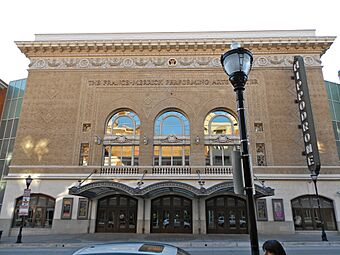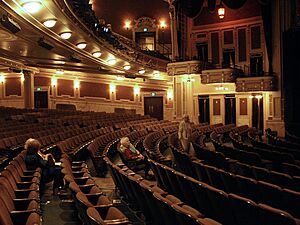Hippodrome Theatre (Baltimore) facts for kids
 |
|
| Address | 12 N. Eutaw St. Baltimore, Maryland |
|---|---|
| Public transit | Baltimore Arena |
| Owner | Maryland Stadium Authority |
| Operator | Key Brand Entertainment |
| Capacity | 2,300 |
| Construction | |
| Opened | 1914 |
| Rebuilt | 2004 |
| Architect | Thomas W. Lamb |
|
Hippodrome Theatre
|
|
| Area | 0.4 acres (0.16 ha) |
| Built | 1914 |
| Architect | Lamb, Thomas White; Singer-Pentz Construction Co. |
| Architectural style | Beaux Arts |
| NRHP reference No. | 99001670 |
| Added to NRHP | January 14, 2000 |
The Hippodrome Theatre is a famous theater in Baltimore, Maryland. It's a historic place where people have enjoyed many different shows and movies for over a hundred years!
Contents
A Look at the Hippodrome's Past
The Hippodrome Theatre first opened its doors in 1914. It was built by Marion Scott Pearce and Scheck. This theater had 2,300 seats and was a very popular place for vaudeville shows. Vaudeville was a type of entertainment with many different acts, like comedians, singers, and dancers.
When it first opened, the Hippodrome was also a movie theater. It was the largest theater south of Philadelphia at that time. A famous architect named Thomas W. Lamb designed the building. He made it look very grand and strong using brick and terra cotta on the outside.
Early Days and Famous Performers
Before the Hippodrome was built, a hotel called the House Hotel stood on the same spot. That hotel was destroyed by a fire in 1912. The new theater was built with about 3,000 seats. It even had a special organ and its own orchestra!
Many famous performers appeared at the Hippodrome in the 1930s. Some of these stars included Jack Benny, Milton Berle, Bob Hope, Dinah Shore, and Frank Sinatra. Sinatra even performed there for the first time with Harry James.
Live shows stopped in 1959, but the theater continued to show movies. The Hippodrome finally closed in 1990. It was the last movie theater left in downtown Baltimore.
The Hippodrome in Movies
Before its big renovation, the Hippodrome was used as a filming location. It appeared in the 2000 film Cecil B. Demented. In the movie, the theater was a secret hideout for a group of filmmakers.
Modern Makeover: Renovations
The Hippodrome Theatre got a huge makeover in 2004. This project combined three old buildings and added a new one. These buildings included the Western National Bank Building and the Eutaw Savings Bank Building. All of them became part of a large performing arts center.
The Maryland Stadium Authority helped lead this big renovation project. After the work was finished, the theater became a place for many different live shows. Today, it is operated by Key Brand Entertainment. The Hippodrome is now part of the France-Merrick Performing Arts Center. It continues to bring exciting performances to Baltimore!


